The Properties of Hematite
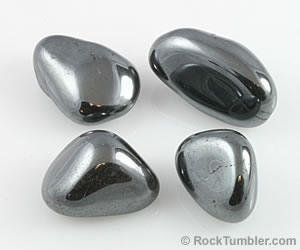
This is the typical appearance of tumble-polished hematite. It is a mirror-bright material with a silver color and a metallic luster. The stones in this photo are representative of the tumbled hematite that we sell on RockTumbler.com.
Hematite: A Popular Tumbled Stone
We sell over fifty varieties of tumbled stones and hematite is one of the most popular. People enjoy its mirror bright luster and its silver color. But, most of all, they are delighted by how its high density produces a "hefty" sensation when it is handled.
There are a number of products being sold with the name "hematite", such as "magnetic hematite" and "iridescent hematite". Most of these products are man-made. We will tell you what they are and how to spot them.
What is Hematite?
Hematite is a very common iron oxide mineral (Fe2O3) that is found in rocks throughout the world. It is the most commonly-mined ore of iron. The steel used to make your car, furniture and even the nails in your home was probably made from iron produced by mining hematite. It is a very important mineral.
We Review These Properties Below
- Color
- Specific Gravity
- Magnetism
- Luster
- Specific Heat
- Streak
Properties of Hematite (color)
The most obvious property of any mineral is its color and the color of hematite in nature is highly variable. It can be red, brown, gray, black or silver in color.
The surprising thing about hematite is that when it is ground into a fine powder it is always red! It is amazing that a black or especially a silver mineral becomes red when it is powdered!
The color of powdered hematite is what inspired its name. The name "hematite" is derived from the Greek word "haimatos" which means "blood red".
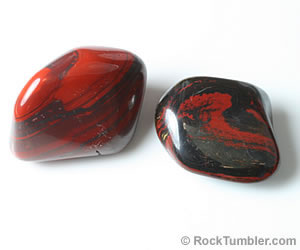
These two rocks are pieces of banded iron ore that have been tumbled to a bright polish in a rock tumbler. They are composed of red jasper and silver hematite. This is the type of material mined in the Mesabi Iron Range and used to make steel for autos, buildings, furniture, tools and more.
Properties of Hematite (specific gravity)
When a person picks up a piece of hematite for the first time they are immediately impressed by its weight. Hematite is very heavy when compared to almost any other substance of similar size. You know that you have something in your hand when you handle hematite.
"Specific Gravity" is the weight of a material compared to the weight of an identical volume of water. Hematite has a specific gravity of 5.3. Quartz has a specific gravity of about 2.65 and most common rock materials have a specific gravity between about 2.5 and 3.0. So, hematite is definitely a weighty material.
Why is specific gravity important? Here are two reasons:
1) When you are buying tumbled stones most varieties of them will have a specific gravity of about 2.6 to 2.8. That means a one-pound bag of medium-size tumbled stones will usually contain about 75 to 110 stones. However, hematite, with its high specific gravity of about 5.3, will only have about 35 to 55 stones in a one-pound bag. Specific gravity makes a big difference when buying tumbled hematite.
2) If you are running a rock tumbler, you are supposed to load the barrel about 2/3 full. Those general rock tumbling instructions assume that you are tumbling a material with a 2.5 to 3.0 specific gravity. However, if you load a rock tumbler barrel 2/3 full of hematite it will be really heavy - probably much heavier than the recommended capacity of your tumbler. So, if you are tumbling hematite be cautious and pay attention to the weight of your barrel. If you have a three-pound-capacity tumbler that means the weight of the barrel, rocks, water and grit should total to about three pounds for a full-capacity load.
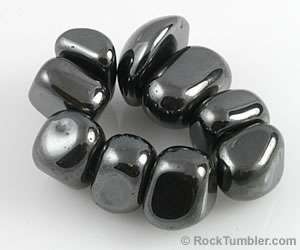
Magnetic hematite? This is another non-hematite that you will sometimes see in gift, tourist, novelty and science shops. They look like tumbled hematite and they are strongly magnetic. These are man-made and they are not even an iron oxide. We think that they should be called "baroque magnets".
Properties of Hematite (magnetism)
Hematite is generally not attracted to a common magnet. If you have a diversity of small hematite specimens from many locations, place them on a tabletop and bring a magnet near them, most will not respond to the magnet. Those that do respond will have a weak to moderate response - typically not strong enough that the magnet can lift them from the table.
If you see a magnetic material being sold with the name "magnetic hematite" that behaves like a magnet, that material is probably not hematite. It could be hematite blended with another material that is magnetic - and that magnetic material is in a high enough concentration to produce a magnetic character. But, most likely it is a man-made material being sold under the name "hematite".
There are man-made magnetic materials named "hematine", "hemalyke", "hemalike", etc. that look like silver hematite but are an entirely different material. These are not hematite, they are not a natural material, and they are just being sold under that name.
Why do they call it "hematite"? They might call it "hematite" because hematite is popular and this material is a hematite simulant (meaning a hematite look-alike). In addition, some people believe that carrying hematite is helpful for relieving the symptoms of certain human ailments (which is not scientifically proven) and magnets are also believed to be helpful in relieving certain symptoms (which is also not scientifically proven), so they believe that the combination of the two will be a powerful cure (which is BS2).
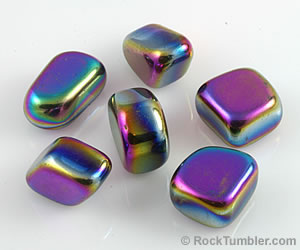
Wow! That iridescent color is spectacular! The material in this photo is known as "iridescent hematite" or "rainbow hematite". It is occasionally seen in gift, tourist, novelty and science shops (and websites). People like it, and buy it. We like it and bought some too! It is a man-made material. The iridescent color is also produced by people. It is a thin coating that will wear off over time - but it's nice while it lasts.
Just so you know... Natural hematite is occasionally seen with an iridescent tarnish - so everything hematite and iridescent is not a man-made substance.
Just so you know... Natural hematite is occasionally seen with an iridescent tarnish - so everything hematite and iridescent is not a man-made substance.
Properties of Hematite (luster)
Hematite is a mineral that occurs naturally with a variety of different lusters. It can have a red or brown color with an earthy luster; a black color with a submetallic luster; or a silver color with a metallic luster. These are the range of lusters for natural hematite.
You might see a material being sold under the name of "iridescent hematite" or "rainbow hematite". It is a product sometimes seen in gift, tourist, novelty and science shops. In most cases this material will be man-made and the iridescent luster will be caused by a thin coating added to the material by humans. If the material is magnetic it is almost certainly man-made.
Occasionally natural hematite can have an iridescent luster, but specimens of this material are quite rare and you will probably only see them for sale by mineral specimen dealers.
Properties of Hematite (specific heat)
If you pick up a piece of tumbled hematite that has not been heated it will usually feel quite cold. It will remain quite cold for a few moments until it absorbs enough heat from your hand to elevate its temperature. Materials that change temperature slowly when in contact with a warm body are said to have a high specific heat. That is one more of hematite's properties.
Properties of Hematite (streak)
"Streak" is the name of a test that geologists do on minerals. It can be extremely helpful in identifying the mineral. In addition, it can signal a potential use of the mineral.
The "streak test" is done by firmly scraping a piece of the mineral across a white piece of unglazed porcelain. This should produce a "streak" of powdered mineral on the streak plate.
Hematite usually produces a surprising streak. Although the mineral might be silvery, black, red, or gray, it always produces a reddish streak. Even if the streak appears to be black, if you look closely you will see that there are traces of red within it. But, much hematite produces a bloody red streak. Ancient people knew this and they used hematite powders to make primitive paints, cosmetics, pigment, and stains to color pottery and clothing.
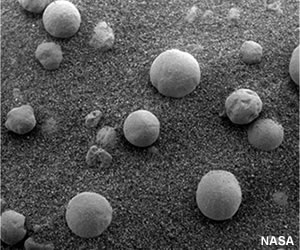
NASA's quote about this image: "When some scientists first saw these strange beads of hematite, they seemed like "blueberries" embedded in a "muffin" of Martian soil."
Hematite on Mars?
Closing with a little hematite trivia...
NASA's Mars Opportunity rover discovered some interesting gray spheres on the surface of Mars. Upon close examination, they concluded that they were rich in the mineral hematite.
NASA scientists could not determine how these spheres formed. Could they have formed when a volcanic eruption sprayed molten material into the Martian atmosphere? Or, were they formed in the immediate aftermath of an impact that launched molten ejecta? Or, did they form out of solution as water diffused through rock or in a standing body of water with wave oscillation? So far, nobody knows.
RockTumbler.com Authors
 |
Hobart M. King has decades of rock tumbling experience and writes most of the articles on RockTumbler.com. He has a PhD in geology and is a GIA graduate gemologist. He also writes the articles about rocks, minerals and gems on Geology.com. |

